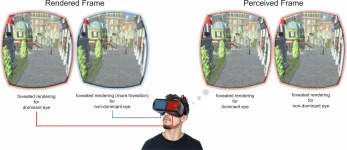Foveated rendering is a breakthrough in computer graphics that is poised to redefine virtual reality (VR) experiences by optimizing visual fidelity and performance. This innovative technique mirrors the natural function of the human eye, which sees in high detail only at the center of focus (the fovea) while peripheral vision remains lower in resolution. By applying this biological principle to rendering, developers can focus computational resources on the exact point the user is looking at, significantly improving performance without compromising visual quality.
One of the key enablers of foveated rendering is eye-tracking technology. Embedded in VR headsets, eye-tracking sensors detect where the user is looking in real time. The system then renders that specific area in high resolution while reducing detail in peripheral zones. This selective rendering reduces GPU load, making it feasible to deliver lifelike graphics at high frame rates, which is crucial for avoiding motion sickness and ensuring immersion in VR environments.
Next-generation VR platforms such as PlayStation VR2 and Meta Quest Pro are beginning to integrate foveated rendering capabilities. These advancements enable more complex and realistic environments without overburdening the hardware. For game developers, this means they can push visual boundaries, adding richer textures, dynamic lighting, and larger open worlds, all while maintaining a smooth user experience.
Beyond gaming, foveated rendering holds promise for industries like medical training, virtual tourism, architectural walkthroughs, and remote education. In medical VR simulations, for example, precise focus areas such as surgical incisions can be rendered in ultra-high detail while less important background elements are simplified, enhancing both performance and training value.
Another major benefit of foveated rendering is its energy efficiency. Reducing the rendering workload can extend battery life in wireless VR headsets and reduce heat generation, both critical factors for consumer adoption. It also opens doors for more mobile and affordable VR solutions that do not require heavy-duty GPUs.
There are still challenges, including latency in eye-tracking systems and potential visual artifacts if the foveated zones are not updated fast enough. However, with rapid advancements in AI-assisted rendering and predictive gaze modeling, these limitations are being steadily addressed.
In conclusion, foveated rendering represents a significant leap in how VR content is delivered. By mimicking the eye's natural focus and integrating real-time responsiveness, it ensures that users enjoy high-quality visuals exactly where they need them, while conserving resources elsewhere. As this technology becomes mainstream, the next generation of VR will offer more immersive, efficient, and visually stunning experiences than ever before.
Join the Conversation:Have you tried a VR headset with foveated rendering?Do you think eye-tracking will become standard in all future VR systems?How do you see this technology impacting industries beyond gaming?
Let us know your thoughts in the comments!
One of the key enablers of foveated rendering is eye-tracking technology. Embedded in VR headsets, eye-tracking sensors detect where the user is looking in real time. The system then renders that specific area in high resolution while reducing detail in peripheral zones. This selective rendering reduces GPU load, making it feasible to deliver lifelike graphics at high frame rates, which is crucial for avoiding motion sickness and ensuring immersion in VR environments.
Next-generation VR platforms such as PlayStation VR2 and Meta Quest Pro are beginning to integrate foveated rendering capabilities. These advancements enable more complex and realistic environments without overburdening the hardware. For game developers, this means they can push visual boundaries, adding richer textures, dynamic lighting, and larger open worlds, all while maintaining a smooth user experience.
Beyond gaming, foveated rendering holds promise for industries like medical training, virtual tourism, architectural walkthroughs, and remote education. In medical VR simulations, for example, precise focus areas such as surgical incisions can be rendered in ultra-high detail while less important background elements are simplified, enhancing both performance and training value.
Another major benefit of foveated rendering is its energy efficiency. Reducing the rendering workload can extend battery life in wireless VR headsets and reduce heat generation, both critical factors for consumer adoption. It also opens doors for more mobile and affordable VR solutions that do not require heavy-duty GPUs.
There are still challenges, including latency in eye-tracking systems and potential visual artifacts if the foveated zones are not updated fast enough. However, with rapid advancements in AI-assisted rendering and predictive gaze modeling, these limitations are being steadily addressed.
In conclusion, foveated rendering represents a significant leap in how VR content is delivered. By mimicking the eye's natural focus and integrating real-time responsiveness, it ensures that users enjoy high-quality visuals exactly where they need them, while conserving resources elsewhere. As this technology becomes mainstream, the next generation of VR will offer more immersive, efficient, and visually stunning experiences than ever before.
Join the Conversation:Have you tried a VR headset with foveated rendering?Do you think eye-tracking will become standard in all future VR systems?How do you see this technology impacting industries beyond gaming?
Let us know your thoughts in the comments!

